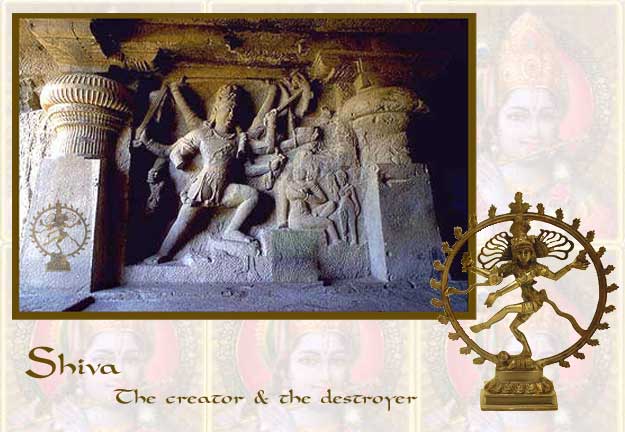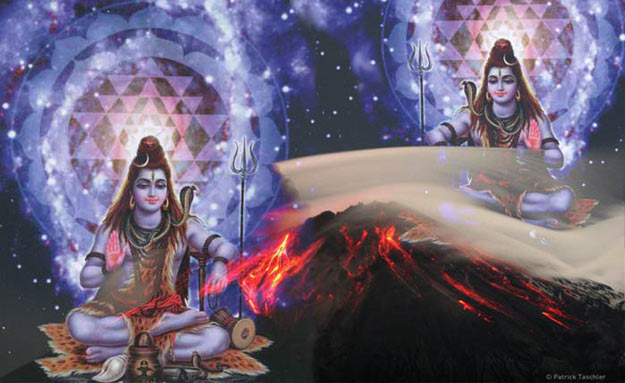
In
the Hindu trinity of Gods, Shiva is the destroyer and renewer. Known
as the Finger of God, this powerful being represents the Will which
determines the rhythm of the worlds.
Thousands
of years before scientists discovered the similarity in structure of
the atomic nucleus of solar systems, the Hindus asserted that the same
rhythm must be found at all stages of creation and in all domains. For
a moment consider rhythm and density, as rhythm acts first and foremost
on density (matter), and plays a role in Hindu thought comparable to
that which we associate with weight and shape.
One
of the forms of Shiva is Nataraja, the Lord of the Cosmic Dance. He
stands in his flaming circle of fire with the upper right hand holding
a little drum-shaped hourglass, the rhythm of which is the world ~ creating
the beat of time, which draws a veil across the face of eternity. His
extended left hand holds the flame of spiritual light that burns this
veil, revealing the void of eternity.
Nataraja's
second right hand is in fear-dispelling posture, and the second left
hand is pointing to the raised left foot. That hand is called the Elephant
Hand and signifies teaching, for where the elephant has gone through
the jungle, all animals can follow. Likewise wherever a teacher leads
the way, disciples may follow.
The
raised left foot signifies release, while the right foot stomps on
the back of Tripurasura, demon of the three lower worlds ~ the mental,
astral and physical planes. Tripurasura is the dwarf of ignorance,
who drives souls into the vortex of rebirth. Shiva gazes in fascination
at the poisonous world serpent, representing humanity’s psychological
attraction into the realm of bondage into unending birth, suffering
and death.
The
god’s head is poised, serene and still in the midst of all
creation and destruction. His right earring is said to be a man’s
and his left is a woman’s, for he includes and transcends opposites.
In his streaming hair is found a skull, the crescent moon, the
datura flower, and a tiny image of the goddess Ganges.
In
former times the Ganges, which now waters the three worlds, washed only
the sky. One day the earth had become so cluttered with the ashes of
the dead that there seemed no possible way to cleanse it. The sage Bhagiratha
thought of bringing the purifying Ganges down to earth, for its mere
proximity was enough to wash away all uncleanness.
But
the sacred river was so large that its descent entailed the risk of
shaking and destroying the earth, just as the sudden descent of willful
divine light on a person insufficiently prepared can destroy their physical
body. Shiva invited the Ganges to fall upon his head, and from there
the river, meandering through the god’s hair, divided into seven
torrents (the seven rays), then flowed on slowly and smoothly over the
surface of the terrestrial world.
There
is an esoteric and close analogy between the purifying Ganges, which
circulates in the universe like the blood in our bodies, and Shiva,
who like the heart, is motionless in rhythm, invoking and directing
life-giving and purifying energy in the universe and in humanity. The
real place of purification for the disciple is the heart; it is in the
heart that the personality and the fruits of action are consumed, and
all that is left is the Divine Spark, the Will of God: ATMA.
The
posture of the dancing Shiva, Nataraja, suggests the shape of the
sign OM, in the head, hands and raised foot. The appearance of this
god resounds the wonder of existence ~ the seed sound, the energy
sound, and the essence of all being.

Symbology
of Shiva
Here
is a key explaining what the different symbols in Lord Shiva's portrayals
depict.
Cremation
ground Shiva sitting in the cremation ground signifies that
he is the controller of death in the physical world.
Matted
locks The three matted locks on Lord Shiva's head convey
the idea that integration of the physical, mental and spiritual
aspects is the ideal of yoga.
Tiger
skin The tiger skin symbolizes potential energy.
Crescent
moon The crescent moon is only one of Shiva's ornaments. In Vedic
astrology, the moon is the mother of planets. Shiva, for creation
of the universe, lends importance to the mother aspect, this is shown
by the moon.
The
moon also is a measure of time, and thus the crescent on Lord Shiva's
head signifies his control over time. Lord Shiva is the Eternal
Reality and he is beyond time. Thus, the crescent moon is only one
of His ornaments, and not an integral part of him.
Three
eyes Lord Shiva, also called Tryambaka Deva, is depicted as
having three eyes: the sun is his right eye, the moon the left eye
and fire, the third eye.
Nandi The
bull is associated with Shiva and said to be his vehicle.
Kundalas Two
Kundalas ~ Alakshya and Niranjan ~ in the ears of the Lord symbolize
the Shiva and Shakti (male and female) or Ardha-Nariswara principle
of creation.
Kamandalu A
water pot ~ Kamandalu ~ made from a dry pumpkin contains nectar and
is shown on the ground next to Shiva signifies that an individual
must break away from attachment to the physical world and clean his
inner self of egoistic desires in order to experience the bliss of
the Self.
Snake
~ Vasuki Naga The snake is shown curled three times around the
neck of the Lord and is looking towards his right side. The three
coils of the snake symbolize the past, present and future ~ time
in cycles.
Rudraksha
necklace Rudra is another name of Shiva. The Rudraksha necklace
worn by the Lord illustrates that he uses the cosmic laws firmly,
without compromise, to maintain law and order in the universe.
Ganga Ganga,
symbolically represented on the head of the Lord by a female (Mother
Ganga), with a jet of water emanating from her mouth and falling
on the ground, signifies that the Lord destroys sin, removes ignorance,
and bestows knowledge, purity and peace on the devotees.
Snake
around the neck The snakes symbolize the yogic power of Lord
Shiva with which he dissolves and recreates the universe.
Varda
Mudra Lord Shiva's right hand is shown in a boon-bestowing and
blessing pose, which annihilates evil, bestows grace,
destroys ignorance, and awakens wisdom in his devotees.
Trident
(Trisula) The three-pronged trident shown adjacent to the Lord
symbolizes his three fundamental powers (shakti) ~ of will (iccha),
action (kriya) and knowledge (jnana).
Damaru
(drum) Damaru symbolizes the two utterly dissimilar states of
existence ~ unmanifest and manifest.
Half-open
eyes When Lord Shiva opens his eyes a new cycle of creation emerges,
and when he closes them the universe dissolves for creation of the
next cycle. The half-open eyes convey the idea that creation is going
through this cyclic process, with no beginning no end.
http://www.souledout.org/healing/healingdeities/shiva/shiva.html
|
Sunday, August 3, 2014
Lord Shiva in Hinduism
If You Like What You See Please Take The Time To Share It!...
Subscribe to:
Post Comments (Atom)





No comments:
Post a Comment